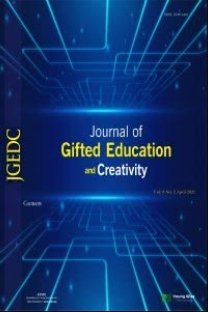Üstün/özel Yetenekli Çocuklarda Mutluluk
Üstün yetenekli çocuklar sosyoduygusal gelişim açısından normallere göre farklılık gösteren bir gruptur. Bu grubun psikolojik özellikleri yaşadıkları problemler üzerine oldukça sınırlı araştırma yapılmıştır. Araştırmaların çoğu bu çocukların eğitimleri üzerine yoğunlaşmıştır. Üstün yetenekliler ile ilgili yapılan ilk araştırmalar bu kişilerin psikolojik iyi oluşları, iş ve gündelik yaşamlarındaki başarıları, evlilik hayatları gibi merak edilen konular üzerine araştırmalardır. Günümüzde de ailelerin çoğu üstün zekalı çocuğunun öncelikle mutluluğuna yönelmektedir. Bu çocukların mutluluk ile ilgili algılarının ne olduğu, zihnilerinde bıraktığı çağrışımın ortaya konması oldukça önemlidir. Normal bireyler ile üstün yetenekli çocukların mutluluk algılarının farklılaşma durumuna, farklı değişkenlere göre değişimine ve psikoloji araştırmalarına önemli katkılar sunacaktır. Bu çalışmada üstün yetenekli çocuklarda mutluluk kavramı tartışılmaktadır. Literatürdeki bulgular ile desteklenerek mutluluk kavramının üstün yetenekli çocuklar açısından nasıl değerlendirileceği ile ilgili yeni bir bakış açısı ile sunulmaktadır.
Anahtar Kelimeler:
üstün yetenekli çocuklar, mutluluk
___
- Ackerman, C. (1997). Identifying gifted adolescents using personality characteristics: Dabrowski's overexcitabilities. Roeper Review, 19(4), 229-236.
- Bailey, C. L. (2007). Social and emotional needs of gifted students: What school counselors need to know to most effectively serve this diverse student population. Paper presented at The 2007 Association for Counselor Education and Supervision Conference.
- Berlin, J. E. (2009). It’s all a matter of perspective: student perceptions on the ımpact of being labeled gifted and talented. Roeper Review, 31, 217-223.
- Brickman, D. C. (1971). Hedonic relativism and plannig the goos society. In M.H. Appley, Adaptation Level Theory: A symposium, 287-302. New York.
- Cantor, N. (1990). Having and doing in the study of personality and cognition. American Psychologist, 735-750.
- Chan, D. W. (2009). Perfectionism and goal orientations among chinese gifted students in Hong Kong. Roeper Review, 31, 1, 9-17.
- Chaplin, L. N. (2009). Please may I have a bike? Better yet, may I have a hug? An examination of children’s and adolescents’ happiness. Journal of Happiness Studies, 10(5), 541–562.
- Colangelo, N., (1991). “Counseling Gifted Students. In N. Colangelo & G. A. Davis (Eds.), Handbook of Gifted Education (pp.273-284). Needham Heights, Allyn And Bacon.
- Cross, T. L. ve Frazier, A. D. (2010). Guiding the Psychosocial Development of Gifted Students Attending Specialized Residential STEM Schools. Roeper Review, 32, 32-41.
- Diener E, S. M. (2002). Very happy people. Psychologial Science, 81-84.
- Fonseca, C. (2011). Emotional intensity in gifted students: Helping kids cope with explosive feelings. Texas: Prufrock.
- Graham, A. ve Anderson, K. (2008). “I have to be three steps ahead”: academically gifted african american male students in an urban high school on the tension between an ethnic and academic identity. Urban Review, 40, 472-499.
- Gross, M.U. (2002). “Play partner” or “sure shelter”: what gifted children look for in friendship SENG Newsletter, 2(2), 1-3.
- Hanchon, T. A., (2007). The relationships among perfectionism, achievement goals, and psychologial adjustment in college students. PhD thesis, Ball State University.
- Holder, M. D. & Coleman B. (2009). The contribution of social relationships to children’s happiness. Journal of Happiness Studies 10, 329–349 DOI 10.1007/s10902-007-90830
- Koizumi, R. (1995). Feelings of optimism and pesimism in japanase students transition to junior to high school. Journal of Early Adolescence, 15, 412-428.
- Neihart, M., Reis, S. M., Robinson, N. M., 8 Moon, S. M. (2002). The social and emotional development of gifted children: What do we know? Waco, TX: Prufrock Press.
- Rask, K., Kurki, P. A., Paavilainen, E. (2003). Adolescent subjective well-being and family dynamics. Scand J.Carin Sci, 17, 129-138.
- Reis, S. M., ve McCoach, D. B. (2000). The underachievement of gifted students: What do we know and where do w ego? Gifted Child Quarterly, 44(3), 152-170.
- Reis, S.M. (2013). Is this really still a problem? The special needs of gifted girls and women. In C. M. Callahan ve H. L. Hertberg-Davis (Eds.), Fundamentals of gifted education considering multiple perspectives (pp. 343-358). NY: Routledge.
- Renzulli, J. (1998). The Three-Ring Conception Of Giftedness.
- Renzulli, J. S. (1991). The schoolwide enrichment model: developing creative and productive giftedness. Boston.
- Schneider, B.H. (1987). The gifted child in peer group perspective. New York: Springger-Verlag.
- Silverman, L.K. (1993). Counseling the gifted and talented. Denver, CO: Love Publishers.
- TDK. (2006). Türk Dil Kurumu. Türkiye.
- Tohum, M. (2018) Özel yeteneklilerin mutluluk kavramına ilişkin metaforik algılarının incelenmesi, Yüksek Lisans Tezi. İstanbul Aydın Üniversitesi. İstanbul.
- Tomlinson, S. (2008). Gifted, talented and high ability: selection for education in a one-dimensional world. Oxford Review of Education, 34, 59-74.
- Tortop, H.S. (2018). Üstün zekalılar eğitiminde farklılaştırılmış öğretim müfredat farklılaştırma modelleri. İstanbul: Genç Bilge.
- Tuzgöl Dost, M. (2005). Öznel iyi oluş ölçeği’nin geliştirilmesi: Geçerlik güvenirlik çalışması.Türk Psikolojik Danışma ve Rehberlik Dergisi, 3, (23), 103–110.
- Uusitalo-Malmivaara, M. (2012). Global and school-related happiness in Finnish children. Journal of Happiness Studies 13: 601–619 DOI 10.1007/s10902-011-9282-6
- Van Deur, P., (2011). “Views Of Gifted Elementary Students About Self-Directed Learning.” Gifted And. Talented International, 26, (1&2), 111-120.
- Vialle, W., Heaven, P. C. L. ve Ciarrochi, J. (2007). On Being Gifted, but Sad and Misunderstood: Social, emotional, and academic outcomes of gifted students in the Wollongong Youth Study. Educational Research & Evaluation, 13, 569-586.
- Wienebrenner, S. (2001). Teaching gifted kids in the regular classroom: Strategies and techniques every teacher can use to meet the academic needs of the gifted and talented: Paperback.
- Yayın Aralığı: Yılda 4 Sayı
- Başlangıç: 2014
- Yayıncı: Genç Bilge Yayıncılık
Sayıdaki Diğer Makaleler
Üstün Yetenekliler Eğitimine İlişkin Bilgi Testi Geliştirme ve Algı Ölçeği Adaptasyon Çalışması
Hasan Said TORTOP, Merve SARAR
Üstün Yetenekli Öğrencilerin Etik İkilemler Karşısındaki Durumları: ÜYÜKEP Programı Örneği
Üstün Yetenekli Çocukların Fen Eğitiminde Bilim Deney Merkezlerinin Rolü
Evlilik Uyumu: Üstün Yetenekli Bireylere Bakış
Filiz GÜLGÖR, Hasan Said TORTOP
Üstün/özel Yetenekli Çocuklarda Mutluluk
Mesut TOHUM, Hasan Said TORTOP
Üstün Yetenekli Öğrencilerde Beklenmedik Başarısızlık
Saadet Yılmaz, Hasan Said Tortop
Serap ÇİFTÇİBAŞI İYİGÜN, Hasan Said TORTOP
Değerler Eğitimi ve Üstün Yetenekliler
Bayram YILMAZ, Hasan Said TORTOP
Üstün Yetenekliler Ahlak ve Karakter Eğitimi Programı (ÜYAKEP) Modeli
